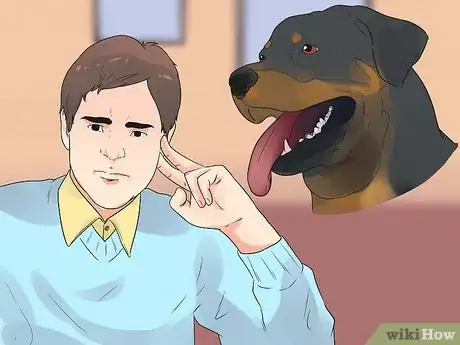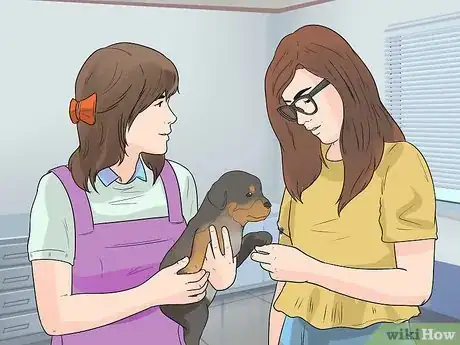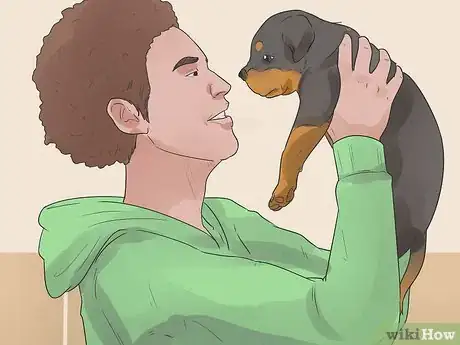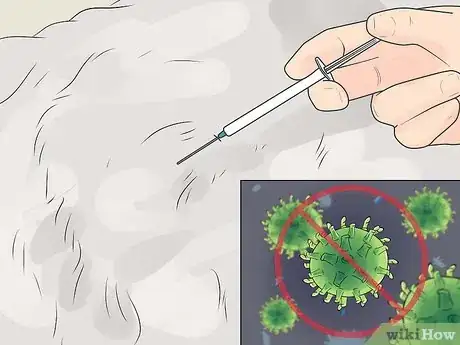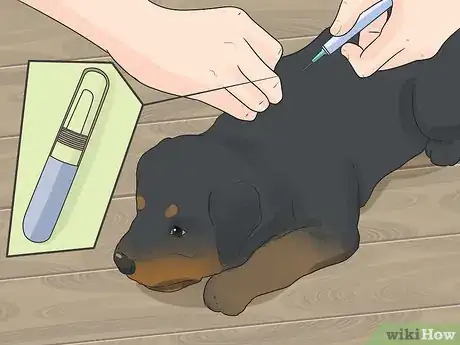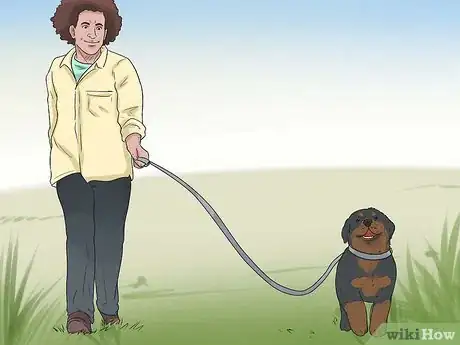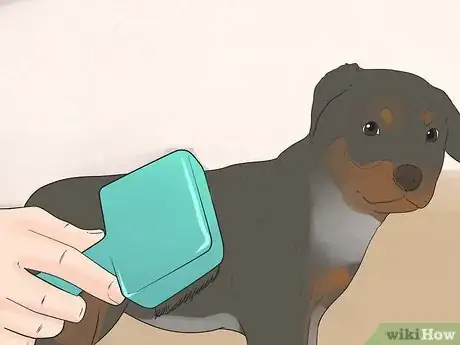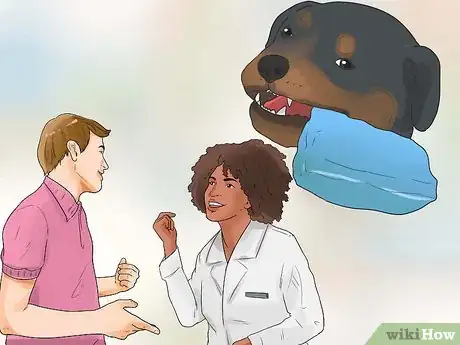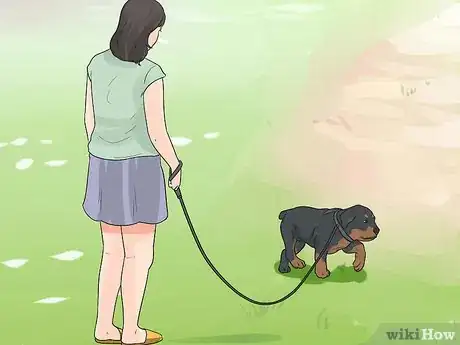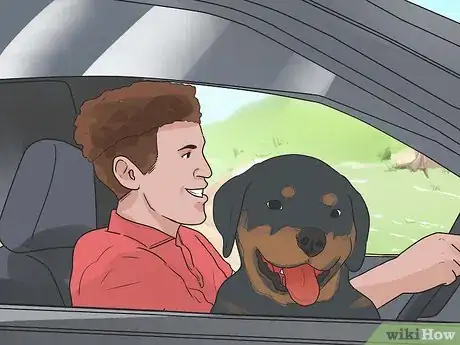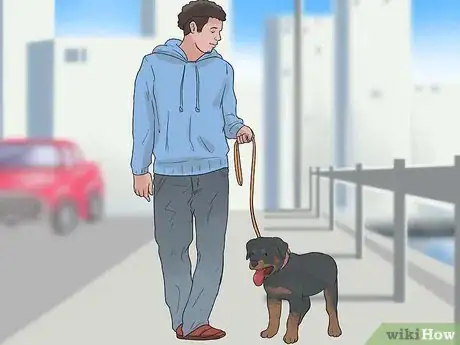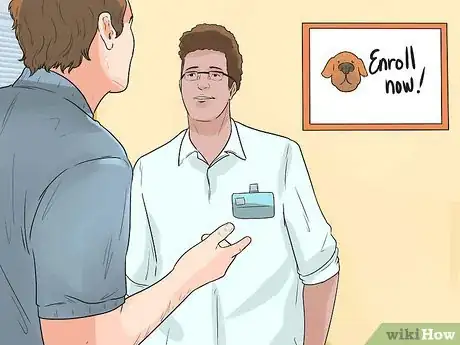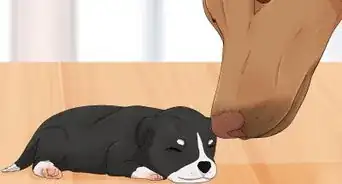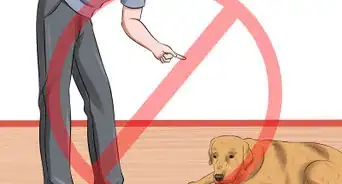This article was co-authored by Brian Bourquin, DVM and by wikiHow staff writer, Jessica Gibson. Brian Bourquin, better known as “Dr. B” to his clients, is a Veterinarian and the Owner of Boston Veterinary Clinic, a pet health care and veterinary clinic with three locations, South End/Bay Village, the Seaport, and Brookline, Massachusetts. Boston Veterinary Clinic specializes in primary veterinary care, including wellness and preventative care, sick and emergency care, soft-tissue surgery, dentistry. The clinic also provides specialty services in behavior, nutrition, and alternative pain management therapies using acupuncture, and therapeutic laser treatments. Boston Veterinary Clinic is an AAHA (American Animal Hospital Association) accredited hospital and Boston’s first Fear Free Certified Clinic. Brian has over 19 years of veterinary experience and earned his Doctor of Veterinary Medicine from Cornell University.
There are 19 references cited in this article, which can be found at the bottom of the page.
wikiHow marks an article as reader-approved once it receives enough positive feedback. This article received 11 testimonials and 85% of readers who voted found it helpful, earning it our reader-approved status.
This article has been viewed 467,740 times.
Rottweilers are highly intelligent, brave, and loving dogs who will be your life companion. When bred and raised properly, a Rottweiler puppy can be a great canine citizen and loyal friend. Rottweilers need experienced handling and are not a good choice for first-time dog owners. With proper socialization and training, your Rottweiler puppy will grow up to be happy and confident.
Steps
Bringing Your Rottweiler Puppy Home
-
1Consider whether a Rottweiler is a good choice. Since there are many differences between dog breeds, it's important to determine if a Rottweiler is right for you.[1] As with any breed, Rottweilers have their own distinct personality traits and breed-specific characteristics. The better you understand Rottweilers, the more aware you will be about the potential challenges related to raising a Rottweiler and how to react appropriately. These puppies become large dogs (around 110 pounds as adults) that are fiercely loyal to their owners and initially wary of strangers.[2]
- Rottweilers need firm guidance from someone who understands dog psychology and behavior, so it helps to be an experienced dog owner with a history of raising good-natured dogs. The potential owner needs to be honest about whether she possesses these skills. Because of a Rottweiler's physical size, a cross Rottweiler who won't get off the sofa when you ask is dangerous.
- To learn more about Rottweilers, go to local dog shows and talk to breeders and other Rottweiler owners.[3]
- Don't forget to check your homeowner's insurance policy. Some insurance policies are void if you get a Rottweiler or any other breed they have labeled as potentially dangerous, even if this labelling is erroneous.[4] If you rent your home, you will need to contact your landlord before adopting a Rottweiler (or any other animal for that manner) to make sure he is welcome.
-
2Choose a reputable breeder. Since there are many Rottweiler breeders, you'll need to take your time to select a quality breeder. Never choose the first breeder you find. Instead, look for a breeder who does all the appropriate health-screenings like the Orthopedic Foundation for Animals screenings for hip, heart, and eye health. To be sure of what you're getting, check for both conformation (show lines) and working ability (Schutzhund or tracking for example) since these show that the puppies look and act like Rottweilers.[5]
- Ask any potential breeder plenty of questions, especially about early socialization with the mother and littermates. It is crucial that the puppy is well socialized and exposed to other people, places, and noises before coming home as these early experiences will help them be confident well-adjusted adults. Be prepared for the breeder to ask you questions about what you're looking for.
Advertisement -
3Select your puppy. Give yourself plenty of time to decide which puppy to take home. You should immediately make sure the puppies and mother are healthy. Then, spend time watching for individual personalities. You won't want to choose a Rottweiler that's timid (since he could become a fearful biter) nor overly aggressive. Look for a puppy that is friendly, approachable, and plays well with his littermates.[6]
-
4Get your puppy vaccinated and de-wormed. Before you bring your puppy home or expose him to other dogs, make sure he's up to date with his vaccinations and de-worming treatments. Distemper shots should start at 6 weeks old with a booster shot about 2 weeks later. After these initial life-saving vaccines are given, you can begin socializing your puppy outside the immediate household. Just remember to take your puppy to the vet for vaccine boosters every year.[7]
- Rottweilers are more susceptible to the parvovirus, a potentially life-threatening illness that causes vomiting and diarrhea.
- Check local laws to determine a rabies vaccine requirement. Most rabies vaccines are started at 12 weeks old and Lyme disease vaccines begin at 9 weeks followed by a booster 3 to 4 weeks later.
-
5Consider microchipping and spaying or neutering your puppy. Local humane societies or your veterinarian can insert a microchip below your Rottweiler's skin. This can help someone return your puppy to you or an animal shelter if he runs off. You should also put an identifying collar around your puppy's neck. It should include your contact information.[8] Talk with your vet about spaying or neutering your puppy, which will prevent unwanted litters and which can offer health benefits.[9]
- Spaying female puppies can reduce stress and discomfort usually experienced when she's in heat, eliminate the risk of mammary and uterine cancer, and prevents unwanted litters.
- Neutering male puppies can reduce the chances of roaming, fighting, and testicular cancer.
Raising Your Rottweiler Puppy
-
1Get your puppy lots of exercise. Take your Rottweiler for at least two 30 minute walks every day. These large breed dogs need a lot of exercise to release energy and stay healthy. If your puppy is under six months old, make sure he has four or five play or exercise periods each day. As your puppy gets older, you can start going on longer walks or hikes.
- Give your Rottweiler toys that stimulate him and keep his mind active. Preventing boredom can also keep your Rottweiler from getting into mischief. Try giving him toys that can be stuffed with food or treats.
-
2Groom your Rottweiler. Luckily, Rottweilers have short hair that makes grooming simple. Brush your puppy once a week using a soft-bristled brush. This will keep his coat healthy and sleek. At this time, you should also check his paws to make sure his nails are short and the pads aren't damaged. Check between each toe for raw or red spots and look over his skin for lumps or bumps. If you find anything out of the ordinary, talk to your vet.[10]
- Keep bathing to a minimum. Washing with shampoo can break down the protective oil in your puppy's skin. When you do occasionally bathe your puppy, use a dog shampoo. It's not as drying as human shampoo or dish soap.
-
3Feed your puppy a nutritious diet. Ask your vet to recommend a high-quality food for your Rottweiler. When choosing a commercial dog food, look for one that lists meat (not meat by-products) as one of the first ingredients listed. Meat by-products are fine to feed but they should be lower down the list. Choose a food specially formulated for large breed puppies.[11] These have the proper ratio of nutrients to build the strong skeletal system these large dogs need.[12]
- Take care to only feed your puppy after he's exercised. If you feed him before, your Rottweiler is at risk of gastric bloat and intestinal twisting.[13] These are serious conditions that can kill your puppy. Instead, wait at least 60 minutes after exercising or four hours before exercising to feed your puppy.
-
4Housetrain your puppy right away. You may want to begin by crate training to prevent accidents in the house. Buy a crate that's sized for a large breed dog and place your puppy's blanket or bed inside the crate, along with a few treats.[14] Leave the door open throughout the day so your puppy can explore it. Start feeding your puppy his food inside the crate and close the door when he is eating. When he is finished, he may whine or cry to get out but do not let him until he quiets down so that he begins to associate the crate with quiet time.[15]
- Never leave your puppy in the crate for more than an hour or two. The crate shouldn't be seen as a punishment. Never leave an adult dog in the crate for more than four to six hours.
-
5Create a routine and be patient. Make a structured routine of times to take your puppy outside to potty. For example, you might take him outside to potty first thing in the morning, after meals or play time, and right before bedtime. Always praise your puppy so he will associate going potty outside and good behavior with pleasing you. You should also watch for signs that your puppy needs to potty and immediately take him outside. Puppies will often sniff, pace, pant, bark or run around the urge strikes.
- Avoid punishing your puppy for accidents inside the house. Just ignore it, clean it up, and try again next time. Never rub your Rottweiler's nose in his mess. It's cruel and may cause your puppy to hide future accidents.[16]
Socializing Your Rottweiler Puppy
-
1Start socializing your puppy at an early age. Puppies benefit from early interaction with new life situations, other dogs, and humans.[17] [18] From birth until about 3 ½ weeks, your puppy needs to be around other puppies and his mother to learn normal dog socialization. From the age of three weeks to twelve weeks your puppy is accepting of new experiences. So, it's a good time to expose your puppy to as many new (but safe) situations as possible: car rides, the outdoors, other pets and animals, humans of various ages and sizes, etc.
- If your puppy was taken away from his mother and littermates at birth and raised alone, he may adapt poorly and have a high chance of aggression towards other dogs.[19]
-
2Make sure your Rottweiler puppy is comfortable. Watch your puppy to make sure he's comfortable with socializing. Certain experiences can overwhelm a puppy and make him frightened. If a situation causes a fearful reaction, gradually introduce him to this experience to give him time to adapt to it. Use your judgement and never force your puppy to remain in a situation or near someone that frightens him. Instead, immediately remove and distract him with a toy or treat.[20]
- Once your puppy is 12 to 18 weeks old, he'll become more cautious in new situations. This is a normal development that helps your puppy learn to be cautious when on his own.
-
3Enroll your puppy in socialization classes. One of the best ways for your puppy to interact with others is through puppy socialization class.[21] At class, your puppy will be exposed to other puppies, people, dogs and a variety of sights, sounds, smells, and equipment. It will also give you a chance to learn training and socialization skills while allowing you to bond with your Rottweiler.
- Ask your veterinarian to recommend classes or sign up with community education centers or large pet stores.
- It's normal to feel overwhelmed by puppy parenthood which will take time, patience, and effort. Things will soon settle into a routine and it may be helpful to talk with others going through the same challenges.
-
4Supervise interactions with other dogs. Since you never know how your puppy will react to other puppies or dogs, always monitor him in social situations. If it looks like your puppy is no longer playing, but is defensive, step in and stop the behavior before he starts fighting. For example, if one puppy is biting another, you should step in[22] especially if the biting puppy is shaking his head and pinning the other to the ground.[23] Make sure both puppies are calm. Then, you can reward them and let them keep playing.
- Be prepared to quickly step in and stop fighting. It may help to have toys to distract, keep your puppy on a leash, or blast an air horn.
- Start basic training from an early age, but make it fun. Your Rottweiler must be properly trained.
Expert Q&A
Did you know you can get expert answers for this article?
Unlock expert answers by supporting wikiHow
-
QuestionWhat should I keep in mind when raising a puppy that will become a large breed like a Rottweiler?
 Brian Bourquin, DVMBrian Bourquin, better known as “Dr. B” to his clients, is a Veterinarian and the Owner of Boston Veterinary Clinic, a pet health care and veterinary clinic with three locations, South End/Bay Village, the Seaport, and Brookline, Massachusetts. Boston Veterinary Clinic specializes in primary veterinary care, including wellness and preventative care, sick and emergency care, soft-tissue surgery, dentistry. The clinic also provides specialty services in behavior, nutrition, and alternative pain management therapies using acupuncture, and therapeutic laser treatments. Boston Veterinary Clinic is an AAHA (American Animal Hospital Association) accredited hospital and Boston’s first Fear Free Certified Clinic. Brian has over 19 years of veterinary experience and earned his Doctor of Veterinary Medicine from Cornell University.
Brian Bourquin, DVMBrian Bourquin, better known as “Dr. B” to his clients, is a Veterinarian and the Owner of Boston Veterinary Clinic, a pet health care and veterinary clinic with three locations, South End/Bay Village, the Seaport, and Brookline, Massachusetts. Boston Veterinary Clinic specializes in primary veterinary care, including wellness and preventative care, sick and emergency care, soft-tissue surgery, dentistry. The clinic also provides specialty services in behavior, nutrition, and alternative pain management therapies using acupuncture, and therapeutic laser treatments. Boston Veterinary Clinic is an AAHA (American Animal Hospital Association) accredited hospital and Boston’s first Fear Free Certified Clinic. Brian has over 19 years of veterinary experience and earned his Doctor of Veterinary Medicine from Cornell University.
Veterinarian You want to look for a puppy food that says it is for large breed dogs. That's going to have the proper ratio of phosphorus, calcium, and other requirements for a large dog's diet. You want these dogs to grow slow, which may seem odd, but you want a large breed to grow at the correct pace so that every part of their body grows together.
You want to look for a puppy food that says it is for large breed dogs. That's going to have the proper ratio of phosphorus, calcium, and other requirements for a large dog's diet. You want these dogs to grow slow, which may seem odd, but you want a large breed to grow at the correct pace so that every part of their body grows together. -
QuestionWhen should I get my Rottweiler puppy spayed or neutered?
 Brian Bourquin, DVMBrian Bourquin, better known as “Dr. B” to his clients, is a Veterinarian and the Owner of Boston Veterinary Clinic, a pet health care and veterinary clinic with three locations, South End/Bay Village, the Seaport, and Brookline, Massachusetts. Boston Veterinary Clinic specializes in primary veterinary care, including wellness and preventative care, sick and emergency care, soft-tissue surgery, dentistry. The clinic also provides specialty services in behavior, nutrition, and alternative pain management therapies using acupuncture, and therapeutic laser treatments. Boston Veterinary Clinic is an AAHA (American Animal Hospital Association) accredited hospital and Boston’s first Fear Free Certified Clinic. Brian has over 19 years of veterinary experience and earned his Doctor of Veterinary Medicine from Cornell University.
Brian Bourquin, DVMBrian Bourquin, better known as “Dr. B” to his clients, is a Veterinarian and the Owner of Boston Veterinary Clinic, a pet health care and veterinary clinic with three locations, South End/Bay Village, the Seaport, and Brookline, Massachusetts. Boston Veterinary Clinic specializes in primary veterinary care, including wellness and preventative care, sick and emergency care, soft-tissue surgery, dentistry. The clinic also provides specialty services in behavior, nutrition, and alternative pain management therapies using acupuncture, and therapeutic laser treatments. Boston Veterinary Clinic is an AAHA (American Animal Hospital Association) accredited hospital and Boston’s first Fear Free Certified Clinic. Brian has over 19 years of veterinary experience and earned his Doctor of Veterinary Medicine from Cornell University.
Veterinarian
References
- ↑ Brian Bourquin, DVM. Veterinarian. Expert Interview. 20 December 2019.
- ↑ http://www.vetstreet.com/dogs/rottweiler
- ↑ www.akc.org/dog-breeds/rottweiler/
- ↑ http://finance.zacks.com/rottweilers-raise-homeowners-insurance-3017.html
- ↑ http://www.akc.org/press-center/facts-stats/responsible-breeders/
- ↑ https://www.aspca.org/pet-care/virtual-pet-behaviorist/dog-behavior/choosing-puppy-litter
- ↑ Cahn CM, Line S. The Merck Veterinary Manual. 9th ed. John Wiley & Sons, 2005
- ↑ http://www.humanesociety.org/animals/resources/tips/microchips.html?referrer=https://www.google.com/
- ↑ Brian Bourquin, DVM. Veterinarian. Expert Interview. 20 December 2019.
- ↑ http://dogtime.com/dog-breeds/rottweiler
- ↑ Brian Bourquin, DVM. Veterinarian. Expert Interview. 20 December 2019.
- ↑ http://www.petmd.com/blogs/thedailyvet/ktudor/2013/may/feeding-the-large-and-giant-breed-puppy-30265#
- ↑ Canine Medicine and Disease Prevention. C. W. Faerber, DVM, S. M. Durrant, DVM, and J. F. Leon, DVM. Animal Health Publications. 1999
- ↑ Brian Bourquin, DVM. Veterinarian. Expert Interview. 20 December 2019.
- ↑ http://www.humanesociety.org/animals/dogs/tips/crate_training.html
- ↑ http://www.americanhumane.org/animals/adoption-pet-care/dog-behavior/housetraining-puppies-dogs.html
- ↑ https://www.aspca.org/pet-care/virtual-pet-behaviorist/dog-behavior/socializing-your-puppy
- ↑ Effects of dog-appeasing pheromones on anxiety and fear in puppies during training and on long-term socialization. Sagi Denenberg, DVM and Gary M. Landsberg, DVM, DACVB. JAVMA. 2008
- ↑ The effects of early experience on the development of inter and intraspecies social relationships in the dog. M.W. Fox and D. Stelzner. Animal Behaviour. Volume 15, Issues 2–3, April–July 1967, Pages 377–386
- ↑ https://www.aspca.org/pet-care/virtual-pet-behaviorist/dog-behavior/socializing-your-puppy
- ↑ Evaluation of association between retention in the home and attendance at puppy socialization classes M. M. Duxbury, DVM; J.A. Jackson; S. W. Line, DVM, PhD, DACVB; and R. K. Anderson. JAVMA. 2003
- ↑ https://www.cesarsway.com/dog-training/dog-socialization-training/dog-not-playing-nice
- ↑ www.thedodo.com/community/MarcBekoff/theres-nothing-simple-about-do-768002870.html
About This Article
To care for a Rottweiler puppy, make sure it gets plenty of exercise by taking it for a minimum of 2 30-minute walks per day. You should also feed your puppy after it has exercised with a high quality commercial feed that contains plenty of meat. Additionally, give it toys stuffed with food or treats to keep its mind stimulated, which can help prevent your puppy from getting into mischief. Early on, you’ll also want to create a routine for taking your puppy outside to the toilet, such as after breakfast and before bed, to house train it. For tips on how to socialize your puppy with other dogs and humans, keep reading!
